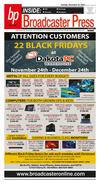122016_YKBP_A9.pdf







Broadcaster Press 9
December 20, 2016 www.broadcasteronline.com
Cold Stress Affect the Energy
Needs of Cattle?
BROOKINGS, S.D. - Most beef producers understand
that when the weather gets colder their cattle need more
energy for maintenance. So at what temperature do cattle
actually begin experiencing cold stress and then how much
more energy do they need? The answer takes a couple of
factors into consideration, explained Warren Rusche, SDSU
Extension Beef Feedlot Management Associate. "The actual
temperature and wind speed interact to determine the effective temperature," Rusche said. He referenced Table 1 which
shows the dramatic effect wind speed has on the effective
temperature the cattle experience. "Based on what we know
about wind's impact on effective temperature - goes to show
that any kind of available protection, whether natural or
man-made, can be very valuable in reducing wind chill and
the negative effects of cold environments," he said.
When do cattle begin to feel cold stress?
The point of cold stress or lower critical temperature,
depends in large part on the amount of insulation provided
by the hair coat. Referencing Table 2, Rusche showed that
insulation value changes depending on the thickness of the
haircoat and whether it is dry or wet. "As a general rule,
for every degree that the effective temperature is below
the lower critical temperature, the cattle's energy needs increase by 1 percent," Rusche said. For instance, if the effective temperature is 17 degrees Fahrenheit, the energy needs
of a cow with a dry winter coat are about 15 percent higher
than they would be under more moderate conditions. That
energy requirement jumps up to about 40 percent higher
under those conditions if the hair coat is completely wet or
matted down with mud. "It's important to remember that
cattle can adapt to short term weather changes relatively
well without a significant impact on performance," Rusche
said. He explained that cattle can deal with a few cold,
miserable days without suffering long-term effects. However,
ignoring the energy costs of long-term cold stress greatly
increases the risk of poor performance later. Muddy conditions in a feedlot are especially detrimental to performance.
"Any steps that can reduce cold stress, such as providing wind protection or bedding will reduce maintenance
requirements and maintain performance," he said. For additional information on the use of bedding in a feedlot, visit
iGrow.org and search for the article titled, Bedding During
Winter Months Pays Off.
Feed in-take
Although beef cows fed high-roughage diets often
respond to cold stress by increasing voluntary feed intake,
the same is not necessarily true for feedlot cattle being fed
high-concentrate diets. "Especially if cattle must contend
with poor lot conditions due to mud, ice, or snow," Rusche
said. There are some management considerations to keep in
mind regarding changes in feed intake in response to cold
stress: Make sure that water is available. Feed intake will
be reduced if water availability is restricted for any reason
such as frozen water lines or slippery footing near waterers.
If the feed availability is limited either by snow cover or access to hay feeders, the cattle may not have the opportunity
to eat as much as their appetite would dictate. Be careful
providing larger amounts of high concentrate feeds. Rapid
diet changes could cause significant digestive upsets. - See
more at: http://igrow.org/news/cold-stress-affect-the-energyneeds-of-cattle/#sthash.8sSMFoAK.dpuf
Managing Cattle through an Arctic Blast
BROOKINGS, S.D. - Extremely cold temperatures are
gripping the cattle feeding areas of the Northern Plains.
Although cattle producers can't alter the weather, there are
management steps that can be taken to help maintain cattle
health and performance, explained Warren Rusche, SDSU
Extension Beef Feedlot Management Associate.
Rusche outlines research which shows that by managing bedding, pens and feed intake, producers can help their
cattle through the extreme weather.
Bedding
"Providing bedding is the most useful tool to improve
cattle comfort, especially in outside yards," Rusche said.
Bedding helps cattle preserve body heat and reduce the
impact of cold stress on maintenance energy requirements.
Visit iGrow to read "Bedding During Winter Months Pays
Off," to gain insights into how using bedding can affect cattle performance during the winter.
When extreme cold weather is expected, feeders should
start bedding sooner rather than later, said Rusche, quoting
Dr. Erik Loe, Consulting Beef Cattle Nutritionist with Midwest PMS, LLC. "His experience suggests that waiting until
cattle are exhausted before providing bedding results in
calves simply "resting up" on the bed pack and rather than
continuing to eat their ration," Rusche said.
He explained that this could result in diminished performance and increase the risk of digestive upset when cattle
resume eating.
In extreme cold conditions, the priority pens for bedding
should be the lightest calves (less than 750 pounds) and
cattle that are within 45 days of being shipped.
Research shows that bedding the almost finished cattle
helps avoid negative impacts on carcass quality and can
also reduce the chances for injury or mobility problems late
in the feeding period caused by cold or icy conditions.
Managing Feed Intake
Keeping feed intake consistent is a challenge during extreme weather conditions. "Some days keeping machinery
running to simply get the cattle fed on time is a major accomplishment. Inconsistencies in feed intake lead to poorer
conversions and in extreme cases, acidosis," Rusche said.
By adding additional roughage to a finishing diet - for
example, feeding 12-13 percent instead of 10 percent
roughage, for instance) - could reduce the impacts of any
inconsistencies in feed consumption.
Backgrounding cattle are usually fed to achieve a certain
ADG (average daily gain) target.
"Extended periods of cold conditions can cause cattle
to fall short, especially if the cold temperatures last for
an extended period of time," Rusche said. "Increasing the
energy content by another 2 to 4 Mcal NEg (megacalories
of net energy for gain) or increasing the amount fed by an
additional 0.2 percent of body weight might be required to
meet production targets."
Pen Maintenance
Lot conditions, particularly ice, can affect feed consumption.
"Slick areas on the feed bunk apron and around waterers
can reduce the willingness of calves to come to eat or drink,
not to mention the increased risk of injury," Rusche said.
Mud can also become an issue. "Keep in mind that
today's snow can easily become tomorrow's mud. Muddy
conditions in the feedlot can be one of the biggest issues
in getting cattle to perform during the winter and early
spring," Rusche said.
Anecdotal evidence suggests that muddy yards can
result in as much as 100 pounds difference in final weight
between cattle of similar genetic type that were fed similar
rations.
Removing snow and scraping outside pens can be
incredibly difficult to accomplish, especially during extreme
weather conditions. However, anything that can be done to
remove snow and improve lot conditions now will pay off in
later as the lot surface starts to thaw.
Safeguarding the Food We Eat
BROOKINGS, S.D. - One out of every six Americans will
become sick from food-related illness in the course of a
year, according to the Centers for Disease Control and
Prevention.
"They're not talking about feeling queasy after a big holiday meal, or heartburn from a convenience store burrito.
That statistic refers to illnesses caused by foodborne germs
such as Salmonella, E. coli and Listeria," said Russ Daly,
Professor, SDSU Extension Veterinarian and State Public
Health Veterinarian.
Daly explained that pathogens can enter food at various
points in the production of food - from the initial animal or
plant source, through processing, to cooking and serving.
"The people involved in making our food take product
safety very seriously. Because many raw products can
harbor some illness-related germs, they go to great lengths
to make sure their processing equipment is not a potential
source of contamination. Large companies spend significant
resources to monitor their processes to ensure safe food
products," Daly explained. "But small food processors have
the same commitment to safety and quality, yet may not
have the resources for their own laboratory and testing
schemes."
To help protect South Dakotans from food borne illnesses, the Animal Disease Research and Diagnostic Lab
(ADRDL) at SDSU has a specific lab dedicated to food safety
testing for smaller, family businesses like the local locker
plant.
"It's a very natural fit," said Daly. He explained that the
Animal Disease Research and Diagnostic Lab serves as the
testing agency for South Dakota's state meat inspection
program.
"Most foodborne germs are very similar to those the
lab routinely diagnoses in cases of animal disease. The lab
already has the people, equipment, and most importantly,
the knowledge to rapidly and accurately detect these germs
in food," Daly said.
On any given day, the food safety lab receives sausage,
lunch meat, beef sticks and similar products from businesses across the state for foodborne pathogen testing. To
ensure their sanitation processes are working, in addition
to meat, the lab also tests samples taken from tables, meat
saws and knives.
"What's more, this level of expertise is recognized by
two other states (North Dakota and Vermont) who also use
SDSU's food safety lab for their inspection programs rather
than those in their own state," Daly said.
Ensuring a Safe Future
Planning is currently underway for an update to SDSU's
Animal Disease Research and Diagnostic Lab, with the goal
of ensuring the facility can continue to serve South Dakotans today and well into the future. To learn more about
this renovation and SDSU's Animal Disease Research and
Diagnostic Lab, visit their website.
Here’s My Card
Advert
ise You
r
Card H
ere!
Call 62
4-4429
& Sewer
• Water t Excavation
en
• Basem n
emolitio
•D
paration
• Site Pre
g
• Ditchin
g
• Gradin
nded
sed • Bo
• Liscen
d
• Insure
ollman
Mike P nda, SD 57073
ako
ravel
and • G
424 • W 5-267-2768
PO Box
Rock • S Fill Material
: 60
ax
e•
063
Phone/F
Quartzit
5-661-1
Cell: 60 ahoo.com
y
xkv8tor@
Broadcaster
Prosadcaster
re s
bp B
Since 1934
S
AM
CKIE WILLI
JA
t
Cherr y
onsultan
201 W.
57069
Media C
308
illion, SD 4-4429
Verm
5-661-2
05) 62
t
Cell: 60
intalk.ne
Phone: (6 24-2696
ms@pla
6
kie.willia
x (605)
ne.com
c
Fa
ronli
email: ja
adcaste
www.bro
t
intalk.ne
www.pla
Press


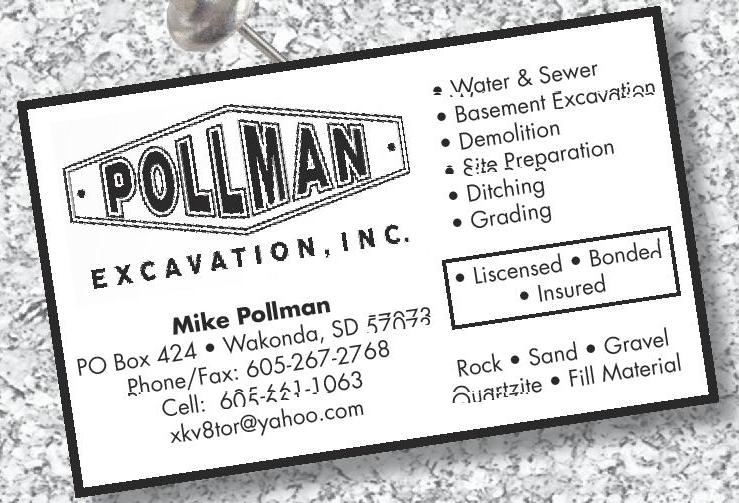

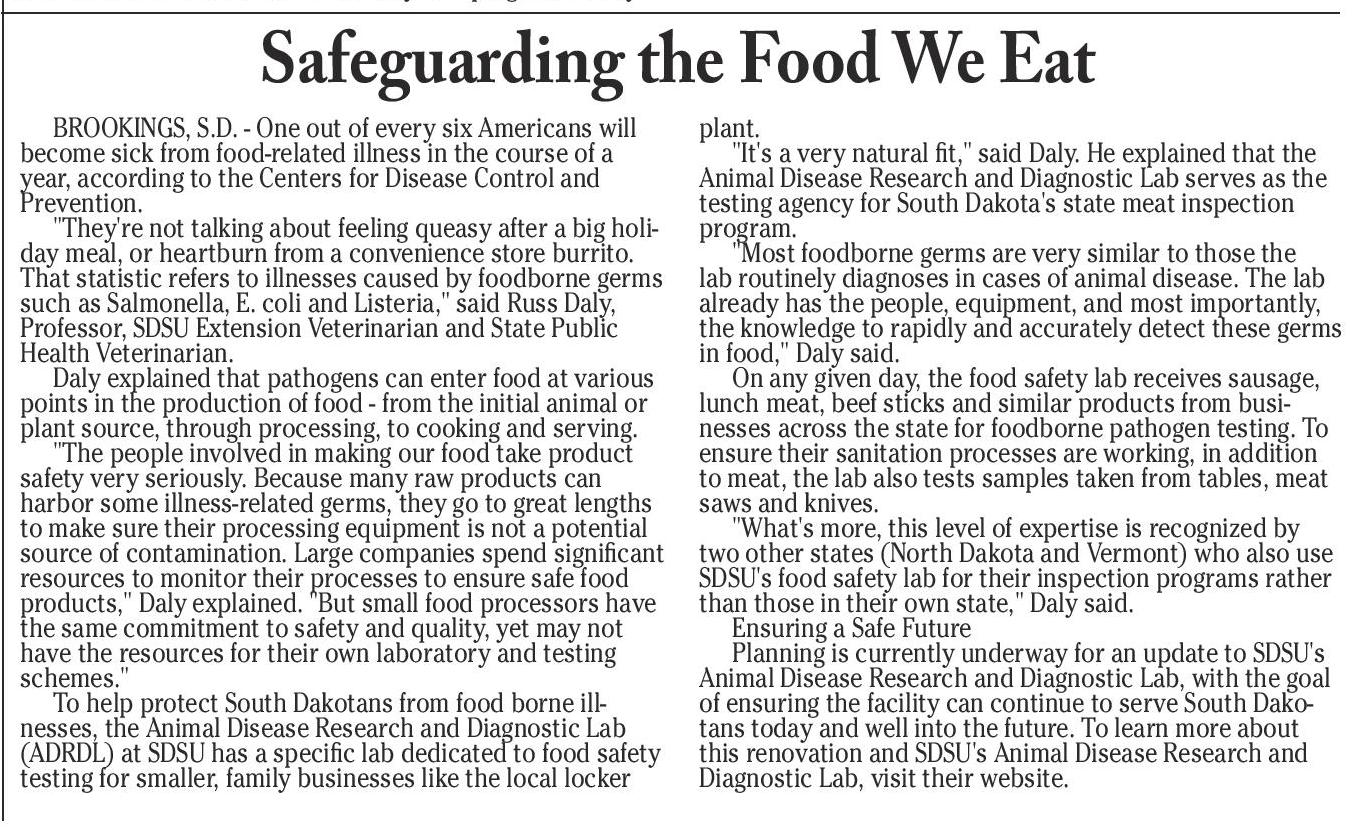

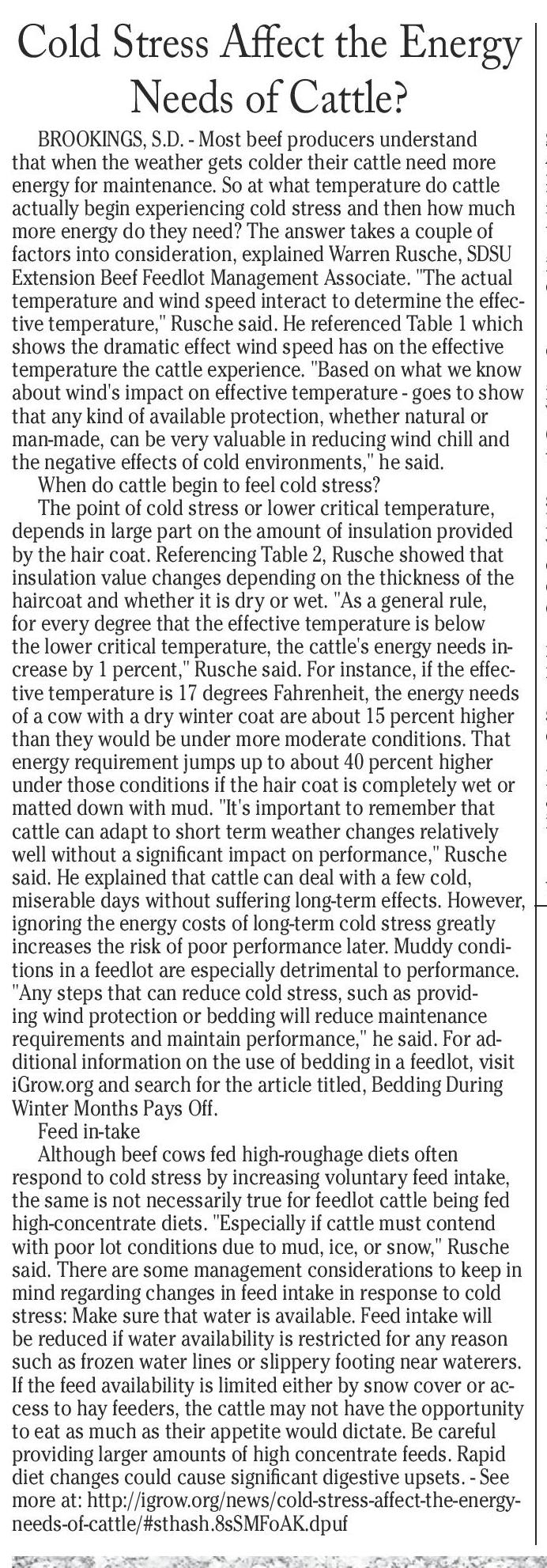

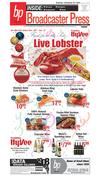

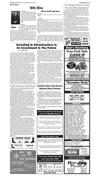
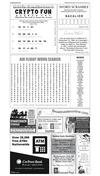
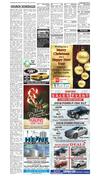
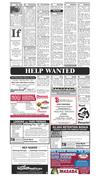

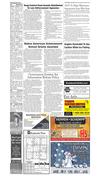


 Previous Page
Previous Page





